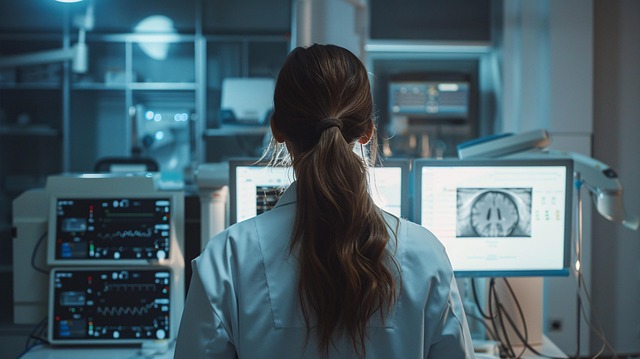Radiographic contrast media enhance medical imaging by increasing tissue density, aiding in diagnosing conditions. In X-rays, they improve lung and vessel clarity for detecting issues like pneumonia or embolism. CT scans use contrast media to visualize organs, blood flow, and identify abnormalities. CXRs, using ionizing radiation and dye, offer real-time, high sensitivity screening, while CT scans provide 3D, high-resolution images with superior detail. The choice between them depends on clinical needs, balancing resolution vs. speed for specific applications.
In the realm of medical imaging, choosing between Contrast-Enhanced X-ray (CEX) and Computed Tomography (CT) scans depends on specific needs. This article delves into the fundamental differences between these two techniques, focusing on radiographic contrast media as a key element. We explore CEX’s mechanism and advantages, CT’s cutting-edge technology and detailed visualizations, and conduct a comprehensive comparison of their sensitivity, resolution, and use cases. By understanding these distinctions, healthcare professionals can make informed decisions for optimal patient care.
Radiographic Contrast Media: Basics and Application
Radiographic contrast media play a pivotal role in enhancing the visibility of internal structures during medical imaging procedures, particularly in X-ray and CT scans. These agents are substances administered to patients before imaging to improve the distinction between various tissues and organs, thereby aiding radiologists in their diagnosis. The basic principle behind contrast media is to increase the density or opacification of specific areas within the body, making them stand out against the background.
In practice, radiographic contrast media are used to highlight blood vessels, organs, or soft tissues. For instance, in a chest X-ray, contrast agents can help visualize the lungs and blood vessels more clearly, which is crucial for detecting conditions like pneumonia or pulmonary embolism. CT scans also benefit from contrast media, allowing for better depiction of abdominal organs, blood flow, and detection of abnormalities such as tumors or inflammatory processes. The choice of contrast agent depends on the type of imaging, body part being examined, and clinical presentation of the patient.
Contrast-Enhanced X-ray: Mechanism and Advantages
Contrast-enhanced X-ray (CXR) utilizes radiographic contrast media, such as ionizing radiation and dye, to highlight specific structures or abnormalities within the body. The mechanism involves administering the contrast agent, which then distributes itself within the body’s tissues or organs. As the X-rays pass through these areas, the contrasting properties of the dye create distinct patterns on the X-ray image, allowing for better visualization. This technique offers several advantages over traditional X-rays. It enhances the ability to detect small lesions, abnormalities, or structural changes in various body systems, including the lungs, blood vessels, and lymph nodes. CXR is particularly useful for evaluating chest conditions, identifying foreign bodies, or monitoring treatment progress. Additionally, it provides real-time imaging, enabling dynamic assessment of processes like contrast uptake by tissues or blood flow patterns.
CT Scans: Technology and Detailed Visualization
CT scans, or computed tomography, represent a significant advancement in medical imaging technology. This technique uses specialized X-ray equipment and computer processing to produce detailed cross-sectional images of the human body. Unlike traditional radiographs that capture a single image, CT scanners rotate around the patient, acquiring multiple projections from different angles. These data are then combined by advanced algorithms to create high-resolution 3D images, offering unparalleled visualization of internal structures.
The key advantage lies in the use of radiographic contrast media, which enhances the visibility of various tissues and organs. This media, typically administered intravenously, contains substances that absorb X-rays differently than body tissues. As a result, specific areas of the body can be highlighted, providing doctors with detailed insights into anatomy, especially when combined with computer reconstruction algorithms. CT scans excel in visualizing complex structures like blood vessels, bones, and organs, making them indispensable for diagnostic purposes across various medical specialties.
Comparison: Sensitivity, Resolution, and Use Cases
When comparing Contrast-enhanced X-ray (CXR) and Computed Tomography (CT), sensitivity, resolution, and use cases are critical factors to consider. In terms of sensitivity, CXRs excel at detecting subtle differences in soft tissue contrast due to the use of radiographic contrast media. This makes them particularly useful for evaluating conditions like pneumonia or pulmonary embolisms where small changes in lung parenchyma can be significant. On the other hand, CT scans offer a superior resolution, capable of distinguishing structures as thin as 1 mm. This enhanced detail is invaluable for detecting complex pathologies within bones, soft tissues, and organs, making CT the go-to choice for evaluating trauma, tumors, and abdominal abnormalities.
Use cases further highlight these differences. CXRs are commonly employed as an initial screening tool in emergency settings due to their speed and accessibility. They provide a quick overview of internal structures, guiding subsequent diagnostic tests. In contrast, CT scans are often requested when more detailed information is required. This includes pre-operative planning, identifying subtle lesions, or evaluating post-surgical complications. The choice between CXRs and CT depends on the clinical question and the need for high-resolution detail versus rapid, broad assessment.
In comparing contrast-enhanced X-rays (CXR) and CT scans, understanding the unique applications of radiographic contrast media is key. CXRs leverage ionizing radiation and contrast agents for real-time visualization, offering advantages in certain scenarios like rapid assessment and cost-effectiveness. On the other hand, CT scans provide detailed cross-sectional images using X-ray rotation, enabling more nuanced diagnosis, especially in complex cases that require high resolution. When deciding between these modalities, consider the specific needs of the patient and the clinical context to ensure the most appropriate imaging technique is employed.
